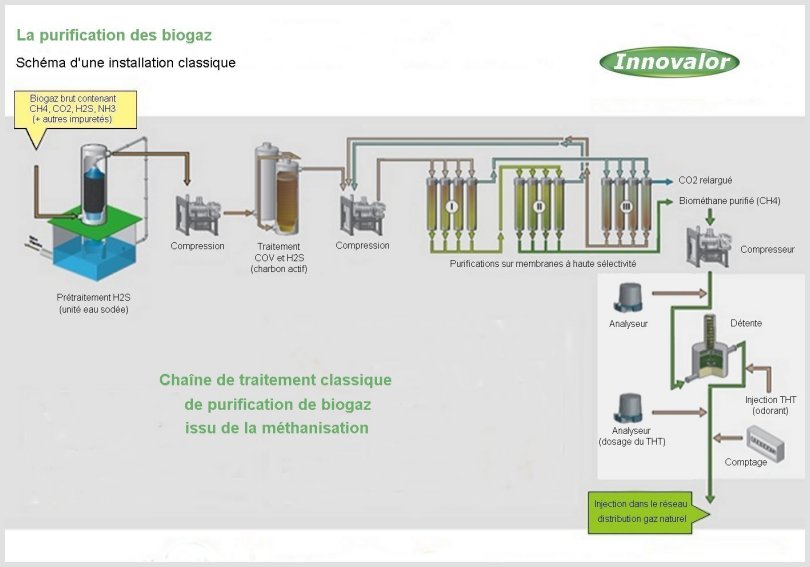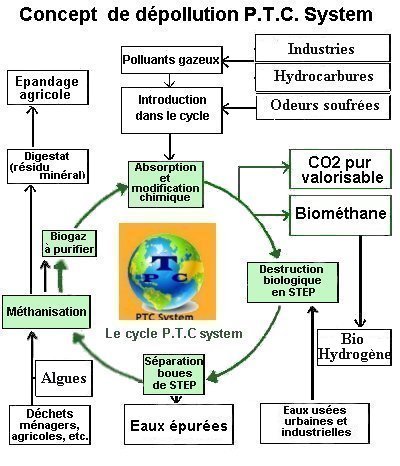|
Whatever
the nature of the biogas, the GASWASH process separates
the biogas from its impurities (CO2, H2S, VOC, Siloxanes).
The methane content of biogas increases from 45%
to 98% and can be directly injected into the national
gas distribution network.
The
advantage of our GASWASH process is that it uses
reliable, robust, widely proven technology that
comes directly from the industry. This system adapts
according to the variation of the methane richness
according to the composition of the incoming crude
biogas.
 Why methanize our waste ?
Why methanize our waste ?
Methanisation,
which is still underutilized to date, appears to
be an answer to the dual issue of waste management
and the development of renewable energies; Not to
mention the fight against greenhouse gases, of which
CO2 is a part.
The
principle of methanization consists in recovering
the organic waste to recover it in the form of biogas
by anaerobic fermentation.
Organic waste can come from agricultural (slurry,
manure), industrial and tertiary (including LPN
waste) or from local authorities (catering waste,
grass clippings ...).
Biogas is composed in particular of methane in variable
proportion, which gives it an energy potential.
This biogas, after purification, is used to produce
electricity and / or heat. It can also be injected
into the gas distribution network, or even used
as a fuel gas.
To
date, the
purification of biogas requires a succession
of operating phases.
The GASWASH process has the advantage of treating
all the undesirable compounds in a single operation.
In
addition to biogas, agricultural methanization allows
the production of a fertilizer, the digestate, which
can be applied (As part of a spreading plan, or
as a standardized product after composting).
The development of methanation is fully in line
with the objectives of the energy transition law
for green growth promulgated on August 18, 2015.
France
wants to develop renewable energies up to 23% of
the energy mix by 2020, with a strong contribution
from biomass to these objectives (wood energy and
methanisation).
Thus, the State sets a target of 1,500 methanizers
in 3 years, and methanisation is at the heart of
the plan Energy Methanization Autonomy Nitrogen
(EMAA) of 29 March 2013 (see
site internet http://agriculture.gouv/Plan-Energie-Methanisation).

It
should be noted that in this configuration, the
biogas is not purified so that it is a source of
olfactory nuisance due to H2S and NH3. On the other
hand, the fermentation CO2 is released to the atmosphere
(greenhouse gases).
 The
current biogas - biomethane sector
The
current biogas - biomethane sector
The uses of biomethane are the same as those of
natural gas: domestic hot water, heating, cooking,
industrial needs, etc. One of the relevant valuations
still unrecognized is the valuation of fuel.
The use of biomethane in transport fuels (known
as bioGNV) would reduce greenhouse gas emissions
in this sector.
Furthermore, on the understanding that bioGNV and
NGV (natural gas for vehicles) have the same chemical
composition, gas-fueled vehicles and filling stations
can be supplied with bioGNV without technical modifications.

Diagram of the conventional
pathway
 The
purification of biogas
The
purification of biogas
To
date, biogas purification is carried out mainly
for the upgrading of biomethane by injection into
natural gas distribution networks of fossil origin.

 |
|
The
diagram above shows the complexity of such
a purification plant comprising several treatment
units and it will be noted that the CO 2,
which is momentarily trapped, is released
to the atmosphere. Such facilities represent
a significant investment and operating cost
(eg, activated carbon costs).
Opposite a processing
unit diagram with the GASWASH process
Le
The GASWASH process, which is innovative because
of its simple but particularly effective technology,
has a prominent place among the
current biogas purification techniques.
It is the only one known to completely eliminate
in the same operation and on a single treatment
unit CO2, N2, O2, H2O, H2S, NH3,
Siloxanes,
Organochlorines ou Organofluorines, etc....
|
 Actualy, what is the CO2 balance
of a methanisation unit?
Actualy, what is the CO2 balance
of a methanisation unit?
|
Each m3 of biogas from methanisation has helped
to avoid the release into the atmosphere of
2.3 kg of carbon
dioxide (CO2) responsible for global warming.
A methanisation unit of 2 MW electrical, by
the principle of methanization, thus avoids
the emission of about 9 000 t of CO2 in the
atmosphere. However, it should be borne in
mind that each m3 of biogas produced always
contains between 20 and 40% CO2, ie between
3 kg and 6 kg.
|
|
This carbon dioxide is ultimately released to the
atmosphere, either during purification in biomethane
by competing techniques or in the use of biogas
without purification.
It should be noted that this same methanisation
unit of 2 MW and which consumed about 4 Mm3 of biogas
nevertheless issued.
Between 800 t and 1600 t CO2 in the atmosphere depending
on the nature of the methanated substances. The
composition of the biogas and therefore its impurities
varies according to the nature.

An INERIS report (15/12/2009) mentions concentrations
of carbon oxysulphide (COS) in the range of 0.047
to 0.29 mg/m3 in biogas from the methanisation of
sludge from sewage treatment plants..
 Biomethane: Towards a cost
of production finally competitive ?
Biomethane: Towards a cost
of production finally competitive ?
The GASWASH process is the only known technology
to date, making it possible to permanently eliminate
and advantageously recover the CO2 resulting from
methanation in the form of carbonates and which
is recoverable in particular in industry.
It allows the total, sustainable and one-stop capture
of both CO2 and all volatile volatile compounds
(N2, O2, H2O, H2S, NH3, Siloxanes,
Organochlorines or Organofluorés).
The
GASWASH process allows a cost of production of biomethane
3 times cheaper than the competition and thus makes
it possible to reduce the cost difference between
the methane of fossil origin and the biomethane
to incorporate it in the network.

 The
GASWASH process: a new innovative process
The
GASWASH process: a new innovative process
The
system for the complete purification of Biogas of
any kind in a single operation and on a single treatment
unit.
| |
|


|
The
recovery of biogas
Composed mainly of methane and carbon dioxide,
biogas is efficiently recovered in biomethane
by purification processes.
This technique, called methanisation, is caused
in digesters, during the treatment of household
refuse, industrial or agricultural waste and
sewage
sludge.
Biogas, resulting from the fermentation of
this waste, is a renewable energy source which,
after purification, can replace natural gas
of fossil origin.
Farmers, industrialists and communities thus
treat their waste while exploiting their energy
and economic potential. The GASWASH purification
solution enables the recovery of all biogas
for injection into the natural gas network,
the production of vehicle fuel (biomethane
gas or liquid) or the production of renewable
hydrogen after biomethane reforming.
The
purification technology using the GASWASH
technique
In order to transform biogas into a substitute
for natural gas, it is necessary to get rid
of all the pollutants.
The GASWASH process proposes a technical solution
that allows biogas producers to efficiently
use biomethane in its process of purification.
The technology used makes it possible to permanently
remove carbon dioxide (recyclable CO2), and
to eliminate in the same operation N2, O2,
H2O, H2S, NH3, Siloxanes,
Organochlorines or Organofluorines.
The
hydrogen sector, starting from methanisation,
should logically find its place in the near
future.
http://www.innovalor.fr/biogaz-biomethane.htm
|
|
|
Another
implementation of the GASWASH process for
the purification of biogas is possible according
to this scheme according to the current methods:

|
| |

The
sustainable phase-out of pollutants
The
P.T.C. system loop
|
|
This
system is currently the only known system
for the long-term elimination of CO2 and which
can be recycled in
the industrial sector.
In a period particularly favorable to the
development of alternative energies to fossil
resources, the prospect of integrating biogas
into the French energy landscape is of political,
economic and environmental interest.
Indeed, the valorisation of domestic, industrial
and agricultural organic residues or the treatment
of wastewater satisfies the notions of sustainable
development and renewable energy, clearly
explained in the recent commitments and international
agreements. The environmental impact of the
implementation of biogas recovery schemes
results in a significant reduction in the
greenhouse gases discharged.
Recent
fluctuations in the costs of importing fossil
fuels have also positively influenced the
renewed economic interest in the production
of energy from biogas, whether directly in
the form of high purity methane gas Or in
the form of electricity.
The
cost of biomethane completely purified by
the GASWASH process is 0,054 € /kWh. When
the cost price in competing systems is around
0.15 €/kWh.
The GASWASH process. Allows a cost of production
of biomethane 3 times cheaper than the competition
and thus makes it possible to reduce the cost
difference between the methane of fossil origin
and the biomethane to incorporate it in the
network.
On the other hand, GASWASH technology allows
an extremely simple biogas purification equipment
whose investment cost is inconsistent with
the existing processes.
|
|
 The P.T.C. system is part of this new concept
of purification / decontamination
The P.T.C. system is part of this new concept
of purification / decontamination
|
Innovalor
is looking for a partner or associate for
P.T.C. System and the DAVID and GASWASH processes

To make an offer
|
|